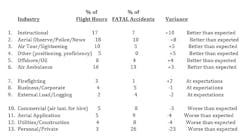Who Rates Best to Avoid Fatal Helicopter Accidents? Who Rates Worst?
Sometimes, numbers don’t reflect the truth. To understand the real story, some numbers need to be placed in the proper context alongside additional data. This also holds true when the safety experts from the U.S. Helicopter Safety Team (www.USHST.org) analyze accident data.
The USHST has looked at 11 years of helicopter operations data from 2009 through the end of 2019 and compared the share of flight hours of every industry type with the percentage share of fatal accidents within those industries. During this period, U.S. civil helicopters flew nearly 34 million flight hours and experienced 233 fatal accidents. Comparing the share of flight hours with the share of fatal accidents within each industry area, the USHST developed this list:
Although instructional flying, aerial observation, air ambulance operations and sightseeing tours have their share of fatal accidents, the numbers are lower than would be expected when compared to their share of flight hours. For example, helicopters within the air tour and sightseeing industry fly 10 percent of U.S. helicopter flight hours, so it would be expected that they would experience 10 percent of all fatal accidents. However, this is not the case. As an industry, they operate more safely than the data would predict.
At the bottom of the list, with more fatal accidents than expected are Personal/Private flying, Utilities/Construction, Aerial Application and Commercial operations. This stems in part because of various risk factors. These pilots fly low-altitude operations or they need to fly near wires. As for Personal/Private, this sector has a higher number of private helicopters with less experienced pilots.
Commercial operations, Aerial Application and Personal/Private flying are three areas that the USHST is focusing on with proposed safety enhancements in order to reduce the fatal accident rate. The data presented here is being used by the USHST to concentrate its efforts in areas of the industry with worse than expected accident and fatality rates.
More information about USHST reports, safety tools, Real Safety presentations and YouTube safety videos also can be obtained at its web site and on the International Helicopter Safety Foundation web site (www.IHSF.aero) and Facebook page.
